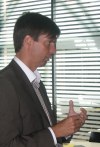
Mika Aaltonen of the BIT Research Centre at the Helsinki University of Technology in Finland argues that at the very fundamental level, human beings are storytelling animals, this premise may seem obvious but arises not because we like fairytales and fables but because of the way we perceive cause and effect. By learning from this revelation it might be possible to understand life stories, consciousness, biological systems, climate economic and business models, and countless physical processes that do not follow the simplistic beginning-middle-end narrative model of cause and effect.
Writing today in the International Journal of Management Concepts and Philosophy (2007, 2, 183-193), Aaltonen explains that our current view of causality is seriously limited because of our intrinsic need to frame a sequence of events as a kind of narrative even when such a storytelling approach does not fit with observations. The concept of time is usually used to connect information explain feedback loops and to provide a logical chronology for causes and their effects. However, things are not so simple in the real world.
Firstly, the way we perceive time is different from culture to culture and across human history and comes with its own baggage. For instance, some cultures have no concept of time at all, others see time as a river along which we flow looking to the future while others imagine our walking backwards away from past events. Modern physics too has destroyed any simplistic interpretation of time in relativity, gravitational theory, and quantum mechanics, in which time becomes not a steady stream from alpha to omega but a framework in which are embedded probability waves, matter, and energy.
Secondly, stretching back as far as Aristotle, and perhaps beyond, there were notions of cause not simply being a one thing must follow another scenario. This is not to suggest that there is anything mystical going on, but just that when we lay down strategies and plans these are often engineered again and again from a top-down position, like the re-working of a fairytale or fable. New characters and happenings may be incorporated but the gist of the process is simply to begin with a “Once upon a time…” and to end with an “…and they all lived happily ever after.” This is not the way things really are.
Aaltonen suggests that the discovery of complexity theory in science and the concept of chaotic and nonlinear behaviour show that cause and effect are much more complicated. However, if we can re-engineer the old philosophical tools we might better understand modern problems and find solutions to them. He suggests that there are three drivers, or forces, of causality – final cause, sensitivity to initial conditions, and circular cause.
“More than imagining and presenting the future as an extrapolation of the present, we should be looking for approaches that allow us to see and influence the future by responding to and influencing what is emerging,” Aaltonen told Sciencebase. This is the first force of causality, the sensitivity to initial conditions. The challenge and the inspiration for sense-making and strategic decision-making, he adds, lie in identifying and influencing the initial conditions of a system as they are emerging. We must prepare ourselves for coming change by identifying the initial conditions so we can shape the future to our advantage. We need foresight in other words!
In addition, circular causality can be used to model causal patterns. Activities on the very small scale do give rise to behaviour we can observe on the large scale. “The general term used for this phenomenon is ’emergence’,” explains Aaltonen, “Consciousness is an emergent property of the brain (and the rest of the body), inflation is an emergent property of an economic system, and meaning is an emergent property of language. Emergent properties are not, however, merely effects, there is multi-way communication.” He points out that phenomena on the large scale (macro level) can affect activity on the small scale (micro-level). “Causality,” he adds, “does not simply work from micro-causes to macro-effects. There is also a top-down process at work which means that causality in complex systems is circular.”
He suggests that if something outside an organism is seen as a final cause, a goal or objective, then voluntary behaviour embeds the organism in the environment. “People’s goal-seeking activities become sensitive to final conditions,” he explains. Small variations in the way a larger environment responds can and should dramatically influence how we ourselves respond to those changes. “This way, final cause becomes a target formed from continuous reflection,” he adds.
Understanding the interplay between these three causal forces is key to planning. It is ironic, he says, that we seem to place a natural emphasis on stories as efficient tools for understanding the world, given that strong stories of the past and the future themselves focus our attention and goals and so are reductive in nature, essentially bringing nothing new to the table.
“There is a need to integrate multiple views into strong and dominant stories and into sensemaking in order to add sensitivity to our understanding of the changes occurring in our world,” he argues. Moreover, strong stories actually drive us towards unobtainable goals in almost every walk of life whereas the essential properties of final cause, sensitivity to initial conditions and circular cause and their interplay demonstrate that causal relationships are shifting shapes in a nonlinear world. “If we are to understand the environments we live in, we require approaches that are reflexive, self-critical and nonlinear,” Aaltonen adds. That sentiment applies equally to stifling poverty and responding to climate change, managing a business or carrying out a scientific experiment.